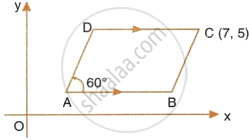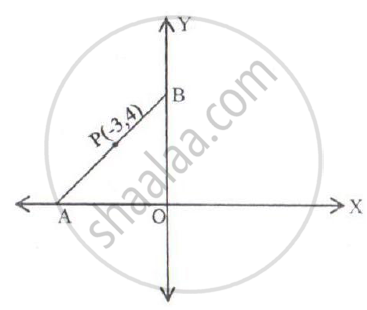Advertisements
Advertisements
प्रश्न
The following figure shows a parallelogram ABCD whose side AB is parallel to the x-axis, ∠A = 60° and vertex C = (7, 5). Find the equations of BC and CD.

उत्तर
Since, ABCD is a parallelogram,
∠A + ∠B = 180°
∠B = 180° – 60° = 120°
Slope of BC = tan 120° = tan (90° + 30°) = cot 30° = `sqrt(3)`
Equation of the line BC is given by:
y − y1 = m(x − x1)
`y - 5 = sqrt(3)(x - 7)`
`y - 5 = sqrt(3)x - 7sqrt(3)`
`y = sqrt(3)x + 5 - 7sqrt(3)`
Since, CD || AB and AB || x-axis, slope of CD = Slope of AB = 0
Equation of the line CD is given by:
y − y1 = m(x − x1)
y − 5 = 0(x − 7)
y = 5
APPEARS IN
संबंधित प्रश्न
In the figure given below, the line segment AB meets X-axis at A and Y-axis at B. The point P(-3, 4) on AB divides it in the ratio 2:3. Find the coordinates of A and B.

Find, if point (-2,-1.5) lie on the line x – 2y + 5 = 0
A line 5x + 3y + 15 = 0 meets y-axis at point P. Find the co-ordinates of points P. Find the equation of a line through P and perpendicular to x – 3y + 4 = 0.
Find if the following points lie on the given line or not:
(2,4) on the line y = 2x - 1
The line y = 6- `(3"x")/2` passes through the point (r,3). Find the value of r.
The line 5x - 3y +1 = 0 divides the join of (2,m) and (7,9) in the ratio 2: 3. Find the value of m.
Find the equation of a line whose slope and y-intercept are m = `2/3`, c = -2
Find the equation of a line passing through the intersection of x + 3y = 6 and 2x - 3y = 12 and parallel to the line 5x + 2y = 10
PQ is straight line of 13 units. If P has coordinate (2, 5) and Q has coordinate (x, – 7) find the possible values of x.
Find the equation of a line passing through (3, – 2) and perpendicular to the line.
x - 3y + 5 = 0.
